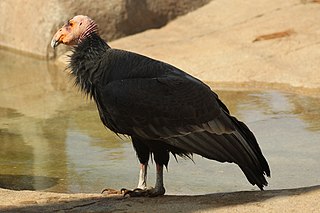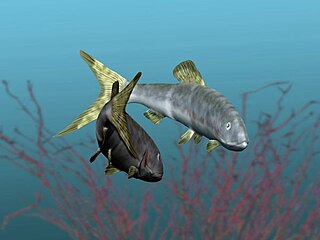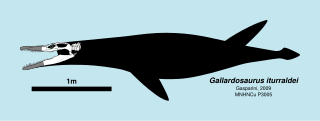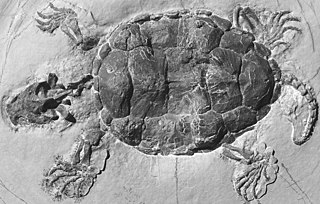
Gymnogyps is a genus of New World vultures in the family Cathartidae. There are five known species in the genus, with only one being extant, the California condor.

The Sierra Maestra is a mountain range that runs westward across the south of the old Oriente Province in southeast Cuba, rising abruptly from the coast. The range falls mainly within the Santiago de Cuba and in Granma Provinces. Some view it as a series of connecting ranges, which join with others to the west. At 1,974 m (6,476 ft), Pico Turquino is the range's – and the country's – highest point. The area is rich in minerals, especially copper, manganese, chromium, and iron.
Delfín Fernández is a former Cuban spy who spent 15 years working for the Cuban counterintelligence Department 11 with the codename Agent Otto. He defected from Cuba and moved to Spain in 1999. He settled in Spain for five years, becoming one of Europe's most successful bodyguards. In 2005 Fernández moved to Miami, Florida and as of 2006 he was waiting to get U.S. residency under the Cuban Adjustment Act.

Cryptoclidus is a genus of plesiosaur reptile from the Middle Jurassic period of England, France, and Cuba.
Nesodactylus was a genus of rhamphorhynchid pterosaur from the middle-late Oxfordian age Upper Jurassic Jagua Formation of Pinar del Río, western Cuba.

Acratocnus is an extinct genus of ground sloths that were found on Cuba, Hispaniola, and Puerto Rico.

Aetobatus is a genus of eagle rays native to the Atlantic, Pacific and Indian Oceans. It was formerly placed in Myliobatidae, but is now placed in its own family Aetobatidae based on salient differences from myliobatids, especially the pectoral fins joining the head at the level of the eyes.

Megalocnus is a genus of extinct ground sloths that were native to Cuba during the Pleistocene and Holocene epochs. They were among the largest of the Caribbean sloths (Megalocnidae), with individuals estimated to have weighed up to 270 kg to 200 kg, around the size of a black bear when alive. Its relatives include other megalocnid sloths, such as Acratocnus, Mesocnus, Miocnus, Neocnus andParocnus. The former species M. zile from Hispaniola is currently thought to be a junior synonym of Parocnus serus.
Vinialesaurus is a genus of plesiosaur from the Late Jurassic (Oxfordian) Jagua Formation of Pinar del Río, Cuba. The type species is Vinialesaurus caroli, first described as Cryptocleidus caroli by De la Torre and Rojas in 1949 under the holotype MNHNCu P 3008, and redescribed by Gasparini, Bardet and Iturralde in 2002. The authors of the 2002 paper considered Vinialesaurus distinct enough from Cryptocleidus to warrant its own genus, but it was broadly similar to Cryptocleidus.
Eugnathides is an extinct genus of prehistoric bony fish that lived from the Oxfordian to the early Tithonian stage of the Late Jurassic epoch. Eugnathides may have been similar to Sphaerodontes.

Luisichthys is an extinct genus of ray-finned fish that lived in what is now Cuba from the Oxfordian to the early Tithonian stage of the Late Jurassic epoch. It contains one species, Luisichthys vinalesensis.

Gallardosaurus is a genus of pliosaurid plesiosaur from the Caribbean seaway. It contains the single species Gallardosaurus iturraldei. Gallardosaurus was found in middle-late Oxfordian-age rocks of the Jagua Formation of western Cuba. Gallardosaurus is believed to be evolutionarily connected to Peloneustes, a pliosaurid commonly found in the Oxfordian-aged sediment.
The Jagua Formation is a Late Jurassic geologic formation in the Sierra de los Órganos and Sierra del Rosario mountain ranges in Pinar del Río Province, western Cuba. Plesiosaur, pliosaur, pterosaur, metriorhynchid, turtle and dinosaur remains are among the fossils that have been recovered from its strata.

Manuel A. Iturralde-Vinent, is a Cuban geologist and paleontologist and former deputy director of the Cuban National Natural History Museum in Havana. He is a scientific personality in Cuba and the Caribbean and President of the Cuban Geological Society for 2007-2016.
Gymnogyps varonai, sometimes called the Cuban condor, is an extinct species of large New World vulture in the family Cathartidae. G. varonai is related to the living California condor, G. californianus and the extinct G. kofordi, either one of which it may have evolved from. The species is solely known from fossils found in the late Pleistocene to early Holocene tar seep deposits in Cuba. G. varonai may have preyed upon carcasses from large mammals such as ground sloths.
The Canímar Formation is a geologic formation in Cuba. It preserves fossils dating back to the Late Miocene to Pliocene period. Among others, fossils of megalodon have been found in the formation.
The Lagunitas Formation is a geologic formation in Cuba. The open marine, fluvio-deltaic and lagoonal claystones, limestones and conglomerates preserve fossils dating back to the Early Miocene period. Among others, the fossil primate Paralouatta marianae, the largest primate of the Miocene New World, was found in the formation. Based on microfossils, the age has been determined as Burdigalian.

Megalocnidae is an extinct family of sloths, native to the islands of the Greater Antilles from the Early Oligocene to the Mid-Holocene. They are known from Cuba, Hispaniola and Puerto Rico, but are absent from Jamaica. While they were formerly placed in the Megalonychidae alongside two-toed sloths and ground sloths like Megalonyx, recent mitochondrial DNA and collagen sequencing studies place them as the earliest diverging group basal to all other sloths. or as an outgroup to Megatherioidea. They displayed significant diversity in body size and lifestyle, with Megalocnus being terrestrial and probably weighing several hundred kilograms, while Neocnus was likely arboreal and similar in weight to extant tree sloths, at less than 10 kilograms.

Platychelyidae is an extinct family of pan-pleurodiran turtles, known from the Late Jurassic and Early Cretaceous of Europe, South America, North America, and the Caribbean. It represents the oldest known clade of stem-pleurodires. All known members have been found in marine or coastal deposits. Despite this, their limb morphology suggests that they were not adapted for open marine conditions, but were likely inhabitants of shallow water environments, including brackish and saline waters, and they likely never inhabited environments more marine than lagoons. Their tolerance for saline environments likely aided their dispersal during the breakup of Pangea. Unlike modern pleurodires, which retract their necks to the sides, Platychelys retracted its neck inwards, similar to modern cryptodire turtles. Platychelys is strongly morphologically similar to mata mata and snapping turtles, suggesting that it had a similar ecology as a ram or suction feeder.









